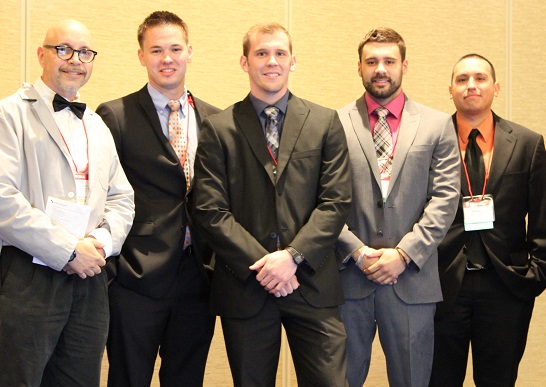Date: Thursday, July 24, 2014
Category: General
People who suffer limb amputations as the result of accidents or infections often wait up to 18 months for a permanent prosthetic, forcing them to rely on family, friends, and caregivers for help with daily activities. The ingenious
“Day to Day Independent Prosthetic,” conceived by engineering students at the University of Toledo, uses inexpensive 3-D printing and widely available hardware, such as cabinet latches and springs, to create a prosthetic designed to increase the use of a limb. Modules that can be attached allow a person to perform a variety of tasks independently, such as picking up a phone, reading a book, or typing on a computer. The design placed first in the
RESNA 2014 Student Design Competition, which annually showcases innovative assistive technology designs that help people with disabilities function more independently. Kyle Wasserman, Daniel Romanko, Derek Weickert and Robert Castilleja were the student designers. The team is shown in the picture with RESNA Awards Master of Ceremony Glenn Hedman.

The Toledo team was also awarded the “Technology Most Likely to Become Commercially Available” prize, which is sponsored by the
Center for the Translation of Rehabilitation Engineering Advances and Technology (TREAT). TREAT is part of the National Institutes of Health (NIH) R24 network of rehabilitation resource centers (# R24HD065703) and is funded through the National Center for Medical Rehabilitation Research (NCMRR) in the Eunice Kennedy Shriver National Institute of Child Health & Human Development (NICHD). The award comes with a $500 cash prize and an internship for one team member at the TREAT facility in Lebanon, NH, to develop the product for market.
In second place,
“The RightFit Prosthetics Initiative,” the brainchild of student designers from Johns Hopkins University, seeks to solve the problem of providing cost-effective prosthetics for the developing world. The RightFit prosthesis includes locally available materials and a socket design that uses low-temperature thermoplastic to mold it directly on the patient’s limb, resulting in a prosthetic that is low-cost, modular, and easily adjustable. The student design team consisted of Nicholas Flower, Rochelle Dumm, Ian Graham, Ada Sierraalta, and Jason Lansdown.
Third place was awarded to
“The Stickler,” a unique device created by occupational therapy students at the University of Toronto to solve the problem of securing public restroom doors for people with little to no hand dexterity due to arthritis. Student design team members were Jonathan Lo, Winnie Ly, and Colleen Anderson.
The three teams were among eight semi-finalist teams out of 42 entries chosen to attend the annual RESNA conference June 13-15 in Indianapolis. Each team presented their designs to the RESNA community of assistive technology professionals, rehabilitation engineers, clinicians, developers, and manufacturers. The remaining five semi-finalist teams were:
- Motorized Spin n' Grin (Duke University) – Lydia Ran, Morganne Gagne, Jayson Garmizo, and Gautam Meka, designers.
- Sticky Solution Custom Tape Applicator (Duke University) – Shweta Mani, Jonathan Liu, Kevin O’Connor, Daniel Piao, designers.
- Play It By Ear (California Lutheran University) – Jennifer Black, Jane Hankins, Roxanne Chandler, Raven Villardo, Tammy Thomsen, Jody Kirby, Krysten Bayani, designers.
- A Fighting Bid (University of North Carolina, Chapel Hill) – Lydia Hatfield, Mae-Lyn Leonard, Brian Castro, William James, designers.
- SMART Materials with Pressure Sensor Application (The Ohio State University) – Molly Mollica, Benjamin Sideritis, Matthew Lynch, Kaitlin DeRussy, Bradley Norval, Halle Stolarsky, designers.
Exposure to the professional assistive technology community at the RESNA conference provides many students with their entry into the field, and student semi-finalists have frequently moved on to become leaders in assistive technology.
The National Science Foundation and TREAT were sponsors.
“We’re looking forward to collaborating with the Day to Day Prosthetic team to further develop this product,” said Jeff LeBlanc, Program Manager of TREAT. “This product has the right ingredients for commercial success – it meets a real need, has novel design components that translate well to a manufacturing environment, and just as importantly it’s clear that the development team has a true entrepreneurial spirit.”
“It’s great to see students with such resourceful approaches to real-world rehabilitation and assistive technology problems,” said Maureen Linden, MS, co-chair of the RESNA Student Design Competition and a researcher at Georgia Institute of Technology. “The teams demonstrated excellence, and I think we’ll see them emerge as leaders in the field.”
Every student design competition submission is available on the
RESNA Student Design Competition website, where members of the professional community can view the designs in detail, provide feedback, ask questions, and contact the designers directly. The deadline for registering to enter the 2015 Student Design Competition is April 3, 2015.